Related Research Articles

West Kalimantan is a province of Indonesia. It is one of five Indonesian provinces comprising Kalimantan, the Indonesian part of the island of Borneo. Its capital city is Pontianak. The province has an area of 147,307 km2, and had a population of 4,395,983 at the 2010 Census and 5,414,390 at the 2020 Census; the official estimate as at mid 2021 was 5,470,797. Ethnic groups include the Dayak, Malay, Chinese, Javanese, Bugis, and Madurese. The borders of West Kalimantan roughly trace the mountain ranges surrounding the vast watershed of the Kapuas River, which drains most of the province. The province shares land borders with Central Kalimantan to the southeast, East Kalimantan to the east, and the Malaysian territory of Sarawak to the north.
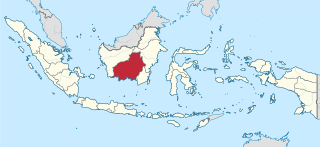
Central Kalimantan is a province of Indonesia. It is one of five provinces in Kalimantan, the Indonesian part of Borneo. Its provincial capital is Palangka Raya and in 2010 its population was over 2.2 million, while the 2015 Intermediate Census showed a rise to 2.49 million and the 2020 Census showed a total of 2.67 million; the official estimate as at mid 2021 was 2,702,200.

Pontianak or Khuntien is the capital of the Indonesian province of West Kalimantan, founded first as a trading port on the island of Borneo, occupying an area of 118.31 km2 in the delta of the Kapuas River at a point where it is joined by its major tributary, the Landak River. The city is on the equator, hence it is widely known as Kota Khatulistiwa. The city center is less than 3 kilometres (2 mi) south of the equator. Pontianak is the 26th most populous city in Indonesia, and the fifth most populous city on the island of Borneo (Kalimantan) after Samarinda, Balikpapan, Kuching and Banjarmasin. It had a population of 658,685 at the 2020 Census within the city limits, with significant suburbs outside those limits. The official estimate as at mid 2021 was 663,713.

Kapuas Hulu Regency is a regency in West Kalimantan province of Indonesia. Located around Kapuas River, it has a total area of 29,842.03 square kilometres or around 20.26% of West Kalimantan province's area. The regency seat is located in town of Putussibau, where most of its economic and government activities take place. Due to its relatively large area, it is sparsely populated compared to neighbouring regencies around it. The regency had a population of 222,160 at the 2010 Census and 252,609 according to the 2020 Census; the official estimate as at mid 2021 was 253,740.

The Banjar or Banjarese are an indigenous ethnic group native to the Banjar regions in the southeastern Kalimantan hemisphere of Indonesia. Nowadays, Banjarese diaspora can be found in neighbouring Banjar regions as well; including Kotabaru Regency, the southeastern regions of Central Kalimantan, southernmost regions of East Kalimantan, and some provinces of Indonesia in general. The Banjarese diaspora community also can be found in neighbouring countries of Indonesia, such as Brunei, Malaysia, and Singapore.

Ketapang or Tau-pang in Teochew is the capital city of Ketapang Regency, one of the regencies of West Kalimantan province on the island of Borneo in Indonesia. Ketapang city is located at 1°51′S109°59′E and is a small city on the delta of the Pawan River. Ketapang is served by the Ketapang Airport.
The Ibanic languages are a branch of the Malayic languages indigenous to western Borneo. They are spoken by the Ibans and related groups in East Malaysia and the Indonesian province of West Kalimantan. Other Dayak languages, called Land Dayak, which are not Ibanic, are found in the northwest corner of Kalimantan, between Ibanic and non-Ibanic Malayic languages such as Kendayan and the Malay dialects of Sarawak and Pontianak.
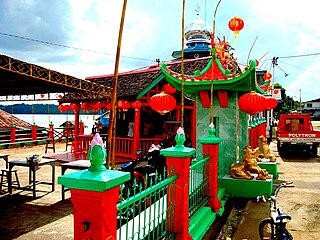
Sanggau Regency is a regency in the north-central section of West Kalimantan province of Indonesia. On 18 December 2003, the regency's eastern portion was split off to create a new regency called Sekadau, leaving Sanggau with an area of 12,857.8 km2 (5,000 sq mi). As of the 2020 census, Sanggau Regency had a population of 484,836; the official estimate as at mid 2021 was 488,527. Alongside Landak, Sekadau, and Sintang, it is one of four West Kalimantan regencies with a predominantly Catholic populations.
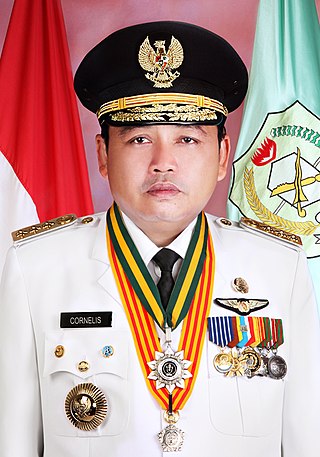
Cornelis is a West Kalimantan governor from 2008 to 2018. He got his master's degree in law from a university in Pontianak in 2004. He is the second Dayak governor in the province after Oevaang Oeray.
Tanjungpura University or UNTAN is a public university in the city of Pontianak in West Kalimantan, Indonesia.
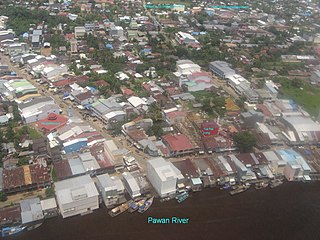
Pawan River is a major river of West Kalimantan, Indonesia. It has a length of 197 kilometres (122 mi). Tributaries include the Keriau River.
Kendayan, or Salako (Selako), is a Malayic Dayak language of Borneo. The exact number of speakers remains unknown, but is estimated to be around 350,000.
Ot Danum is a Barito language of the central Borneo, Indonesia, spoken by the Ot Danum people. Dialects include Cihie and Dohoi.
The Pontianak incident consisted of two massacres which took place in Kalimantan during the Japanese occupation of the Dutch East Indies. One of them is also known as the Mandor Affair. The victims were from a wide variety of ethnic groups, and the killings devastated the Malay elite of Kalimantan, with all the Malay Sultans of Kalimantan executed by the Japanese.
Pontianak Malay is a Malayan language spoken in Pontianak, Indonesia and the surrounding area.

Agustinus Jelani was an Indonesian Dayak politician, and the chairman of the Dayak Unity Party from 1947 until 1958. He was also a member of the Senate of the United States of Indonesia, representing West Kalimantan, member of the People's Representative Council from 1950 until 1956, and the member of the Constitutional Assembly of Indonesia from 1956 until 1959.

Wilda Octaviana Situngkir also popularly known as Wilda Octaviana is an Indonesian Child Protection Commission Ambassador, Indonesian National Agency of Drug and Food Control Ambassador, actress and model who won the title of Puteri Indonesia Pariwisata 2018. She represented Indonesia at the Miss Supranational 2018 pageant, where she placed as the 3rd runner-up, repeating the same achievement by Cokorda Istri Krisnanda Widani in Miss Supranational 2013, Wilda became the fifth Indonesian to be placed as a finalist in Miss Supranational history, continuing the ongoing 4th year placement streaks of Indonesia, consecutively since Gresya Amanda Maaliwuga in 2015, Intan Aletrinö in 2016 and Karina Nadila Niab in 2017.
The Dayak Desa War or Majang Desa War was an armed uprising by the Dayak Desa tribe, and later Indonesian nationalists, in West Kalimantan against the Japanese Empire and the Dutch East Indies during World War II. The war was initially caused by the local population's opposition against the rōmusha system and disappointment with Japanese occupation. In the initial phase of Japanese occupation, several Japanese companies entered the region to gain natural resources in order to support the Japanese war effort in the Pacific. Occupying Japanese forced locals to work for free for these companies, mainly in coal mining and timber production. After that, a Japanese foreman working in a company wanted to marry the daughter of Pang Linggan, a respected Dayak chief in the region, which caused more tension between locals and the Japanese. Dayak tribes in the region initiated mangkuk merah ritual, as a sign to mobilise men from villages and prepare for war. The Japanese were driven out of the Borneo interior in June 1945, but returned on 17 July and continued until 31 August 1945 when Japanese forces there surrendered and left the region, replaced by Allied forces including the Dutch, who would later be opposed again until recognition of Indonesian independence in 1949.
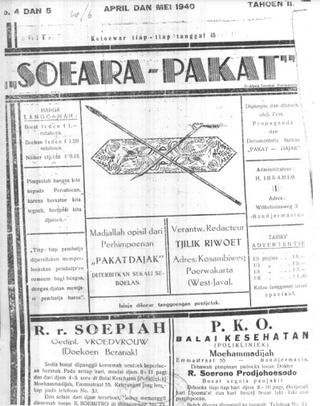
Dayak in politics refers to the participation of Dayaks to represent their political ideas and interests outside of their community. The movement has continued to have a profound impact on the development of Indonesia and Malaysia, especially in Kalimantan and Sarawak.

The Mempawah Kingdom, also known as the Mempawah Sultanate, was an Islamic Dayak kingdom located in a territory now known as the Mempawah Regency, West Kalimantan, Indonesia. The name Mempawah is taken from the term "Mempauh", which is the name of a tree that grows in the upper reaches of the river, also known as the Mempawah River. In its development, Mempawah became known as the name of one of the kingdoms and sultanates that developed in West Borneo. The history of Mempawah is divided into two periods, namely the Dayak kingdom based on Hindu teachings and the period of Islamic influence.
References
- ↑ Backshall, Stephen (2003). Rough Guide to Indonesia. Rough Guide. p. 818. ISBN 1-85828-991-2.
- ↑ "Kalimantan Museums and Art Galleries: Kalimantan, Indonesia". www.world-guides.com. Retrieved 2020-05-07.
- ↑ "Museum Negeri Pontianak". Lonely Planet.
Coordinates: 0°2′54.1″S109°20′35.1″E / 0.048361°S 109.343083°E